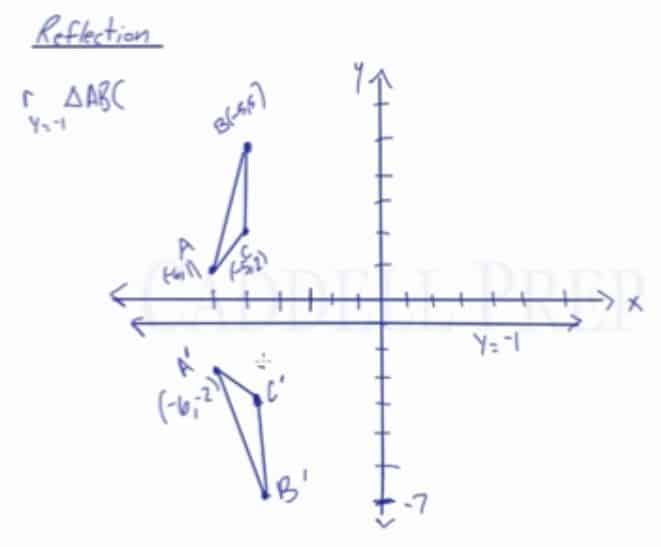In this video, you will learn how to do a reflection over a horizontal or vertical line, such as a reflection over the line x=-1.
Let’s use triangle ABC with points A(-6,1), B(-5,5), and C(-5,2).
Apply a reflection over the line x=-3
Since the line of reflection is no longer the x-axis or the y-axis, we cannot simply negate the x- or y-values. This is a different form of the transformation.
Let’s work with point A first. Since it will be a horizontal reflection, where the reflection is over x=-3, we first need to determine the distance of the x-value of point A to the line of reflection. We’ll be using the absolute value to determine the distance.
Since point A is located three units from the line of reflection, we would find the point three units from the line of reflection from the other side. The y-value will not be changing, so the coordinate point for point A’ would be (0, 1)
Repeat for points B and C. In the end, we found out that after a reflection over the line x=-3, the coordinate points of the image are:
A'(0,1), B'(-1,5), and C'(-1, 2)
Vertical Reflection
Apply a reflection over the line y=-1
The procedure to determine the coordinate points of the image are the same as that of the previous example with minor differences that the change will be applied to the y-value and the x-value stays the same.
In the end, we would have
A'(-6,-2), B'(-5,-7), and C'(-5, -3)
Video-Lesson Transcript
Let’s say we want to reflect this triangle over this line. A line rather than the
-axis or the
-axis.
So, we have
This line is called because anywhere on this line
and it doesn’t matter what the
value is.
Graphically, this is the same as reflecting over the -axis.
We’re just going to treat it like we are doing reflecting over the -axis. Let’s see how far away it is.
Point is
units from the line
, so we’re going
units to the right of it. Keep the same height. And we have
.
Same thing for points and
.
is
units away so we’re going to move
units horizontally and we get
.
Point is
units from the line so we go
units to the right and we end up with
.
The reflection of triangle will look like this.
Probably it’s best to do this graphically then get the coordinates from it.
Similarly, let’s reflect this over a vertical line.
This line represents because anywhere on this line is
, it doesn’t matter what the
value is.
We’ll treat this the same way as we treat everything so far in reflection.
Point is
spots away from the
axis so we’ll go
spots below it. And we end up with
.
is
spots above the line so we’ll go
spots below it. We end up with
.
Point is
spots away so we’ll go
spots below
line.
Now, we can draw a triangle.
We’re able to get the new coordinates graphically by graphing it.
As we look at it, we can now figure out the coordinates.
Looking at the graph, we’ll see that:
A quick sketch easily helps us figure out the coordinates for the image if we reflect triangle over the line
.



